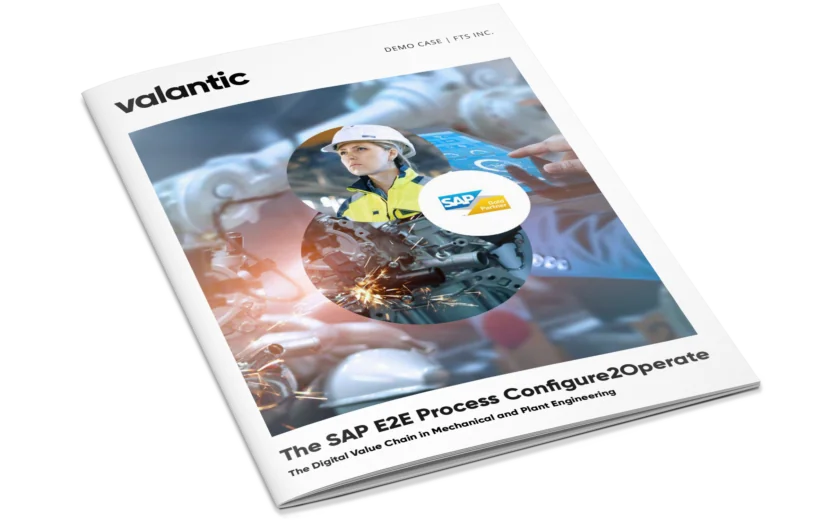End-to-End Process Configure2Operate in Mechanical & Plant Engineering


Globalized markets with high pressure for change, enhanced customer orientation – in some cases even including bespoke production – and the trend towards more sustainability in the value and supply chains: The demands on mechanical and plant engineering are immense. In this challenging environment, end-to-end (E2E) digitized business processes give companies the agility and resilience they need to adapt to changing conditions and stay ahead of the competition. This is why valantic developed the end-to-end process Configure2Operate. It covers every phase of the product lifecycle – from machine or plant configuration through to operation.
Our system demo uses the example of the fictitious FTS Inc., a manufacturer of automated guided vehicles (AGV), to show which SAP solutions can be used in mechanical and plant engineering to digitize the value and supply chains end to end and improve their flexibility, resilience and sustainability. The focus is on the interaction of various SAP applications for the process steps Quotation and Configuration, Solution Order Management, Production Planning and Execution, Creation of the Digital Twin and Monitoring, Service Order Execution, and Data-Driven Controlling. These are state-of-the-art processes that are fully integrated in the SAP cloud solutions. Harmonized user interfaces ensure a largely uniform application experience across the entire process.
With the end-to-end process Configure2Operate, FTS Inc. maps the entire business process – from preparing the quotation to delivery of an AGV, including its service and maintenance – using entirely standard SAP functionalities. The transport system is configured individually for the customer, produced in accordance with the parts list and modeled as a digital twin. This digital twin supports subsequent services and enables controlling over the entire product life cycle.
Configure2Operate consists of six seamlessly transitioning steps: Quotation and Configuration, Solution Order Management, Production Planning and Execution, Creation of the Digital Twin and Monitoring, Service Order Execution, and Data-Driven Controlling.

SAP End-to-End Prozess Configure2Operate to Read
You can learn more about our end-to-end process Configure2Operate for the machine and plant engineering sector in our e-book.
FTS Inc. is a manufacturer of machines, systems and services for manufacturing and automation tasks, including automated guided vehicles.
FTS’s solutions can be used across all industries. Important business areas are the international glass and building materials industry as well as intralogistics.
FTS Inc. likes to offer customers turnkey solution packages that bundle products and services.
The solution packages are configured individually for each customer, with modularization helping to reduce complexity.
The company covers the entire product life cycle, from quotation and maintenance, to repair and controlling, in a single integrated process in SAP.

Quotation and Configuration
The process starts by preparing a customer-specific quotation for the AGV and its configuration. FTS Inc. uses SAP Configure Price Quote (SAP CPQ) for this. The solution enables sales staff to create customized quotes with optimized pricing, variants and accompanying documents in just a few minutes, even for complex products and solution packages. Thanks to the integration with SAP Sales Cloud, all the necessary master data are available in CPQ, allowing customer information to be imported conveniently into the quote. Manual changes can be made at any time if required. Staff can access the catalog via an ergonomic user interface, where they can search for the right product or part, add it to the quote and manage favorites. The configuration of the solution packages can also be initiated here.
In the configurator, users are guided through an intuitive process in which the parts lists and price calculation function also run simultaneously. Discount options are available as well. The solution also informs of any decisions that need to be made. During configuration, sales staff have a wide range of templates available in different languages for conveniently generating all the necessary quotation documents. The quote can be sent directly from the solution, adjusted in accordance with the customer’s response and finally converted into an order in SAP S/4HANA.
Direct import of all customer data and quote information thanks to integration with SAP Sales Cloud
Access to the product catalog, including product search function
Structured, guided configuration process in which bills of materials and price calculation also run simultaneously
Customized discount options
Preparation of all quotation documents from templates available in multiple formats and languages
Direct dispatching of quotes to the customer
Integration with SAP S/4HANA for downstream order management, production, delivery and billing
After the customer has accepted the offer, SAP S/4HANA Cloud creates a solution order. This new object type allows FTS Inc. to seamlessly link its sales and service functions. Solution order management helps the company offer fully integrated solution packages and thus generate higher margins. These packages can include products as well as various one-off and recurring services, such as the installation and commissioning of the AGV and regular maintenance.
Customer service can access different object types in a solution order – such as the sales items of the AGV, as well as the service contract items, such as on-site installation and battery tests. Dependencies between the objects and order items can also be stored. To this end, products and services are added to the solution order and all relevant details, such as project schedule, organizational data and history, are taken over. In this way, it is possible to monitor the project’s progress and inform any involved parties about status changes. Based on the solution order, SAP S/4HANA creates various order types – such as sales or service orders – and combines these into a complete order. The solution order can be used to trigger overall invoicing. Comprehensive controlling is also possible.
New central solution portfolio
Ability to manage follow-up documents such as order, service contract, and service call
Ergonomic graphical representation
Status overview of follow-up documents
Serves as an overall controlling object for the turnkey solution
Single sales order reference applies to all invoices for the turnkey solution sold

For production planning and management, including the material requirements planning run, FTS Inc. uses SAP S/4HANA and the embedded Production Planning & Detailed Scheduling (ePP/DS) application. The preliminary planning created with this is transferred to SAP Digital Manufacturing Cloud (SAP DMC) for production execution on the shop floor, i.e. the fine-tuned production orders are released in SAP S/4 HANA and replicated in SAP DMC. In this cloud-based manufacturing execution system (MES), the production planners on the shop floor use the pre-scheduled data to plan staffing for the next shift, short-term planning of production orders and their release for execution. In doing so, defined production process designs support the interaction between machines, rules, actions and workflows for execution and automation on the shop floor. Once the production order has been released, a shop floor control (SFC) number is automatically generated. This serves as the central object for monitoring and tracking the order and enables production for batch size 1.
During production execution, DMC triggers the provision of the required components through its integration with SAP Extended Warehouse Management (SAP EWM). DMC assists production workers with, among other things, a customizable dashboard that displays the pending worklist, a flexible assembly workflow, and automated checks during production. When the last operation of the production order is complete, DMC sends a final confirmation to SAP S/4HANA and, with the completion message, the creation of a digital twin is initiated in the SAP Asset Intelligence Network (SAP AIN) collaboration tool. In addition, the goods receipt is integrated in SAP EWM.
Synchronization of the manufacturing order data between the integrated systems SAP DMC, SAP S/4HANA Cloud, SAP EWM and SAP AIN
Defined production process designs (PPD) for interactions between machines, rules, actions and workflows for execution and automation on the shop floor
Triggering of component provisioning into SAP EWM
Staff scheduling and planning of manufacturing orders for the “last mile”, such as the next shift
Flexible, system-controlled assembly workflow
Automated inspection during production with integrated work instructions
Automatic updating of consumption postings with SAP EWM
Automatic posting of goods receipts with SAP EWM
Production reports for the order with standard functionalities
Creation of the digital twin and transfer to SAP AIN
24/7 DMC Edge as a hybrid cloud edge option for manufacturers to reduce connectivity, latency and bandwidth dependencies
The collaboration tool SAP Asset Intelligence Network supports the cooperation between FTS Inc., its customers and spare parts suppliers via the digital twin of the transport robot concerned. The previously in Asset Central created digital twin receives basic information from other SAP systems within SAP AIN and is enriched with additional data relevant to the customer and other partners, such as location, installation date, spare part information, and technical documentation. Instructions for scheduled maintenance and photos of damage can also be stored. As soon as the equipment has been published in SAP AIN, all partners can work with the digital twin and view all the machine data that the equipment sends to the platform.
This allows monitoring and lets recommendations for action be derived. Users can determine, among other things, when scheduled maintenance is due or if a malfunction has occurred. In this case, AIN initiates the service process. In our scenario, the AGV’s battery has overheated. As soon as the physical equipment sends the appropriate real-time temperature data, that exceeds a limit value, AIN automatically sends an e-mail notification to the person responsible. This person, in turn, creates an emergency ticket with a status description for customer service directly in AIN which serves as the basis for the service order later on. In addition to the measured values a description of the condition can be added.
Automatic creation of a digital twin as equipment
Equipment enriched with documentation and information
Information sharing with business partners and customers
Linking of the physical equipment with the digital twin for monitoring purposes

The service notifications generated in AIN and the service contracts with standard maintenance performances received in the SAP S/4HANA solution order are transferred to SAP Field Service Management (SAP FSM). There, customer service dispatchers plan and control the execution of service orders. In SAP FSM, employees can display all the available information, such as where a deployment is needed, which appropriately qualified service technicians are currently in the vicinity, and the other assignments they need to complete. For deployment planning, dispatchers can also call up the equipment’s history and store checklists for service calls.
Once the assignment has been released, the field service technicians can access all the required information in the SAP FSM mobile app. In the app, employees can confirm the order, document travel and working time, view safety instructions, work through checklists, input expenses and materials used, prepare service reports on site, and upload photos and other documents. All the information is transferred to SAP S/4HANA, assigned to the service order, and flows into the billing and controlling processes.
Manual or automated scheduling of service technicians, taking into account their locations and qualifications
Transparent overview of service assignments
Mobile app for service technicians with checklists and relevant deployment information
Service feedback while on the road
Preparation of the service report with signature on the customer’s premises
Customizable configuration of various deployment types, such as maintenance or installation
For the controlling and reporting of the solution order and other objects, FTS Inc. uses the analytics solution SAP Analytics Cloud. With this, FTS’s customer service determines all the relevant data, information and KPIs and prepares them for different stakeholders at the customer. SAP Analytics Cloud merges the information from various source systems, such as the digital twin in AIN, SAP S/4HANA, DMC, FSM and third-party solutions. SAP Analytics Cloud thus serves as a single point of truth and single point of entry.
Preparing and analyzing the data lets different information needs be addressed. Customer service can show, for example, whether the investment in the automation solution has paid off, the number of transports made with it per day, and the weight transported per trip. At the same time, automated forecasts and simulations can be prepared to clarify, for example, whether a lower weight per trip affects the loading cycles or maintenance intervals. For the customer, this is important information for optimizing operations.
Merging of information from different source systems in a single tool
Aggregation and preparation of data in accordance with different stakeholders’ information needs
Numerous visualization options
Automatic forecasts that can be prepared and implemented based on customized parameters
Automatic grouping of data and analysis of outliers